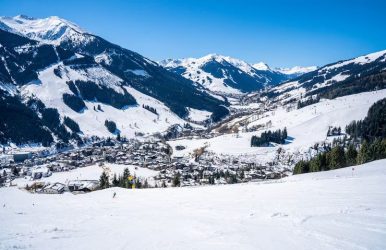Top 4 Reasons to Visit Les Deux Alpes for Your Ski Break
BY Barsha Aug 16, 2023
There's something magical about the snowy mountainside that can entice even the most reluctant of travelers to take a chance and experience the exhilaration of skiing. And when it comes to skiing destinations, few places compare to Les Deux Alpes in southeastern France. In this article, we'll explore the top four reasons why you should visit Les Deux Alpes for your next ski break. 4 Reasons To Visit Les Deux Alpes During Ski Break Situated right at the center of the French Alps, Les Deux Alpes offers breathtaking views, endless slopes, and an abundance of activities for all levels of skiers. Reason 1: Extensive skiing terrain One of the biggest draws of Les Deux Alpes is its extensive skiing terrain. With over 220 kilometers of slopes, skiers of all levels will have plenty of runs to choose from. From gentle beginner slopes to challenging black runs, there's something for everyone. The resort also offers off-piste skiing for the more adventurous skiers, with opportunities for heli-skiing and ski touring. The resort is also known for its high-altitude skiing, with runs reaching up to 3,600 meters. This means that skiing is possible even in the late season, making Les Deux Alpes a popular destination for spring skiing. Don’t forget to book your ski pass at Erna Low in order not to waste your time waiting in long lines. Reason 2: Great for families and beginners While Les Deux Alpes offers plenty of challenging runs for experienced skiers, it's also a great destination for families and beginners. The resort has a dedicated beginners' area with gentle slopes and ski schools for all ages. The ski institutes provide a range of lessons, from group lessons to private lessons, which is relatively easy for everyone to gain knowledge at their own speed. The resort also has a range of activities for non-skiers, including snowshoeing, ice skating, and tobogganing. There are also child-friendly activities, like a sledding area and a snow garden, making Les Deux Alpes a great choice for families with young children. Reason 3: Apres ski and nightlife Les Deux Alpes isn't just about skiing - it's also one of the most awesome Alpine Apres-ski resorts. The resort has a range of bars, restaurants, and nightclubs catering to all tastes. Whether you want to enjoy a quiet drink after a day on the slopes or party until the early hours, you'll find something to suit your mood. One of the most popular apres-ski activities in Les Deux Alpes is ice skating. The resort has a large ice rink that is open throughout the day and into the evening, making it the perfect place to unwind after a day on the slopes. There is also a range of restaurants and cafes around the rink, serving everything from hot chocolate to cocktails. Reason 4: Stunning scenery Finally, Les Deux Alpes is known for its stunning scenery. Located at the heart of the infamous French Alps, the resort offers breathtaking views of the surrounding mountains and valleys. There is also a range of activities for those who want to take in the scenery, including snowshoeing and guided mountain walks. One of the most popular activities in Les Deux Alpes is a ride on the Jandri Express cable car. Tips To Keep In Mind While Visiting Les Deux Alpes Who doesn’t enjoy a holiday with their favorite set of people at Les 2 Alpes? The snow across the glacier and cannons surely make you refreshed and energized. But there are certain factors one should keep in mind while traveling to Deux Alpes. Shortlist The Places You Wish To Travel Visiting a ski resort is fun, but not everyone in your group will agree on a common plan. Different people would want to travel to different parts of the city. Hence, in order to avoid confusion and conflicts, prepare a list beforehand. Hand out the list of common places everyone will visit collaboratively to each group member. This way, each one of you can enjoy without worrying about individual interests. Catalog Skiing Needs People with their personal cars and ski equipment have no worries about storing the boards, skis, and shoes in their trunks. But what about the rest? They might want to try new skis. The skis technology never stands still- a titanium and carbon plate adds extra speed to the ski. Choose an all-mountain freeride ski if you wish to travel off-piste. In case you are a technical skier, rent an additional sharp-carved ski. Maximum hotels have preset agreements and collaborated with ski rental companies offering extra discounts. Check Out Fun Things To Do In Les Deux Alpes It’s time to spice things up a bit. This step is also important to determine the individual interests of each group member. Les Deux Alpes offers everyone a range of entertainment zones. Check them out here: Ice Glider Who doesn’t love to drive bumper cars? But would you dare to drive them on icy ground? This activity might charge you around 5 euros for 5-6 minutes, and only two people are allowed in a single Ice Glider. Also, it is open from 4 pm to 10 pm on Thursdays. Bowling At 12 Place de L’Alpe de Venosc, you get bowling with six lanes. A maximum of 8 players in each lane can play, which makes advance booking highly significant. The cost is somewhere around five euros for each person in the game. There are also darts and air hockey, along with a minibar. Wrap Up Winter sports holidays are totally fun for your physical and mental well-being. And when you visit Les 2 Alpes, fun is guaranteed. Make sure you take note of the aforementioned tips to make your stay a pleasurable experience. So, this was all about it. I hope you liked the article which guided you all the way through ski holidaying in Les Deux Alpes. Don’t forget to share your experiences with us. Happy reading! Read Also: Taco Bell Breakfast Hours: When Does Taco Bell Serve Breakfast? You Won’t Believe The Best Things To Do When In Fiji! Romantic Weekend Breaks Scotland











